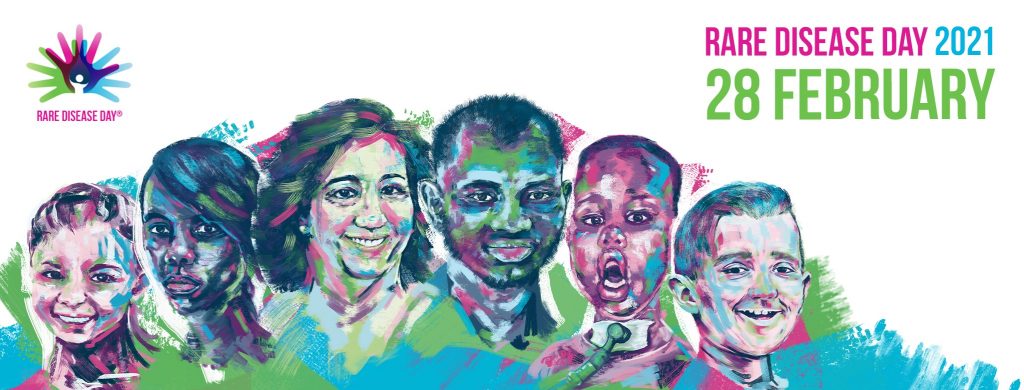CCP celebrates the Rare Disease Day 2021

The CCP primary goal is to perform excellent research. In the period 2021 – 2030, together with other foreign centers gathered in the International Mouse Phenotyping Consortium we plan to deliver jointly broad-based genomic insights into the function of human genetic variation in both coding and non-coding sequences that underpin future developments in precision medicine, rare disease, clinical genetics, and healthy living and aging.
All these efforts and outputs are freely available to the world-wide research community, irrespective of the users’ background if they are coming from academia or the industrial sphere.
On the occasion of the Rare Disease Day celebrated on 28th February, the CCP is delighted to share with public its recent achievements in the area of rare diseases:
Angelman Syndrome
Angelman Syndrome (known also as a happy puppet syndrome) is a rare genetic disease, which causes mental retardation, deficiency in motor skills, absence of speech and other unpleasant symptoms.
CCP is involved in a collaboration with the Prague based Association of Genetic Therapy, z.s. which is a voluntary organization of patients and professionals aiming to support research on potential treatment of rare genetic disorders such as Angelman Syndrome. CCP director Radislav Sedlacek is member of the ASGENT scientific board.
“The aim of the research is to study selected genes and biological processes that are involved in the development of Angelman’s syndrome. Understanding them can be important in finding a cure for genetic defects”, says Radislav Sedlacek, CCP director.
Netherton Syndrome
Netherton Syndrome is a disorder that affects the skin, hair, and immune system. Newborns with the syndrome have skin that is red and scaly, and the skin may leak fluid. People with Netherton syndrome have hair that is fragile and breaks easily, this feature is known as bamboo hair. Most people with Netherton syndrome have immune system-related problems such as food allergies, hay fever, asthma, or an inflammatory skin disorder called eczema.
“We got a complete picture of the causes of Netherton’s syndrome thanks to a mouse mutant model that has three genes altered at the same time. Until recently, something similar was not possible. Only the availability of new gene modification technologies such as TALEN or CRISPR has allowed us to create a similar model. There is no doubt that in the foreseeable future these tools will make it possible to understand a number of other human diseases and thus contribute to their treatment“, says Petr Kašpárek, principal investigator from CCP.
Kasparek P, Ileninova Z, Zbodakova O, Kanchev I, Benada O, Chalupsky K, Brattsand M, Beck IM, Sedlacek R. KLK5 and KLK7 Ablation Fully Rescues Lethality of Netherton Syndrome-Like Phenotype. PLoS Genet. 2017 Jan 17;13(1):e1006566.
Link: https://doi.org/10.1371/journal.pgen.1006566
Prader–Willi Syndrome
Prader–Willi syndrome is a genetic disorder caused by a loss of function of specific genes on chromosome 15. In newborns, symptoms include weak muscles, poor feeding, and slow development. Beginning in childhood, those affected become constantly hungry, which often leads to obesity and type 2 diabetes.
CCP deputy director Jan Rozman, renowned expert in energy balance regulation, is member of the Preclinical Animal Network (PCAN) of the Foundation for Prader-Will Research based in the United States. PCAN is working to create a preclinical screening platform for relevant drug candidates to improve and de-risk PWS drug development.
Amelogenesis imperfecta
Amelogenesis imperfecta is rare genetic disorder mostly affecting the development and mechanophysical characteritics of tooth enamel. Under normal conditions the tooth enamel is the hardest tissue in our body with extremely high resistance against chemical, mechanical and biological stress. Tooth enamel has very complicated and very organized structure, which can be hampered by mutations in multiple genes, which are causative for amelogenesis imperfecta disorder. At CCP we study the function on enamel matrix protein like ameloblastin, amelogenin or enamelin in process of enamel maturation. Understanding of biological functions of these proteins helps us to understand to pathology of disease causing mutations. Beside known enamel matrix protein we focus also on two genes which are responsible for amelogenesis imperfecta without known molecular mechanism such as Fam46a and Fam83h. Finding the molecular function of these gene might help us in search for possible therapies.
Wald T, Spoutil F, Osickova A, Prochazkova M, Benada O, Kasparek P, Bumba L, Klein OD, Sedlacek R, Sebo P, Prochazka J, Osicka R Intrinsically disordered proteins drive enamel formation via an evolutionarily conserved self-assembly motif. Proc Natl Acad Sci U S A 2017 114(9): E1641-E1650
Link: https://www.pnas.org/content/early/2017/02/13/1615334114
